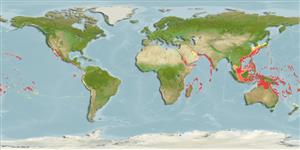Common names from other countries
Classification / Names / Names
ชื่อสามัญ | ชื่อพ้อง | Catalog of Fishes (gen., sp.) | ITIS | CoL | WoRMS
Environment: milieu / climate zone / depth range / distribution range
นิเวศวิทยา
; ระดับความลึก 10 - 150 m (Ref. 93550). Tropical
Indo-Pacific and the Mediterranean: Mediterranean to Midway Island and Easter and Salas y Gómez islands.
Length at first maturity / ขนาด / น้ำหนัก / Age
Maturity: Lm ? range ? - ? cm Max length : 2.2 cm TL เพศผู้/กระเทย; (Ref. 2922)
Attached to rocks (Ref. 75840).
Life cycle and mating behavior
วัยเจริญพันธุ์ | การสืบพันธุ์ | การวางไข่ | เซลสืบพันธ์ของเพศเมีย(ไข่) | ความดกของไข่ | ตัวอ่อน
Members of the class Bivalvia are mostly gonochoric, some are protandric hermaphrodites. Life cycle: Embryos develop into free-swimming trocophore larvae, succeeded by the bivalve veliger, resembling a miniature clam.
Taylor, J.D. and E.A. Glover. 2004. (Ref. 8021)
IUCN Red List Status (Ref. 130435)
CITES status (Ref. 108899)
Not Evaluated
Not Evaluated
Threat to humans
Harmless
Human uses
| FishSource |
เครื่องมือ
ข้อมูลเพิ่มเติม
Age/Size
การเจริญเติบโต
Length-weight
Length-length
สัณฐานวิทยา
ตัวอ่อน
อุดมสมบรูณ์
แหล่งที่มาจากอินเตอร์เน็ต
Estimates based on models
Preferred temperature
(Ref.
115969): 23 - 28.6, mean 26.6 (based on 220 cells).
Vulnerability
Low vulnerability (10 of 100).
